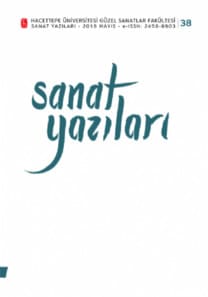SANAT ESERİNİN BAĞRINDA OLAN BİTENE İLİŞKİN OLARAK HEIDEGGER VE BENJAMIN’İ BİRLİKTE OKUMAK
Bu yazı sanat eserinin kendisine odaklanmak üzerinden ortaklıkları bulunan Martin Heidegger ve Walter Benjamin’i birlikte okuyarak, sanatta olan bitenin tartışılma düzlemine ilişkin bir yoklama sunar. Heidegger, hakikatin sanat eserinde gerçekleştiğini belirtir. Ama bir yandan da sanatın artık hakikatin taşıyıcısı olmaktan uzaklaştığına ilişkin tartışmaları anımsatır. Benjamin günümüzde sanatın yaşadığı bu değişimi, sanat yapıtının teknik aracılığıyla yenidenüretimi temelinde açıklar. Sanat yapıtının teknik aracılığıyla yeniden-üretilebildiği çağda, özel atmosferinin/aylasının (aura) çöktüğünü söyler. Bu durumun kitleselleşmeyle bağlantılı olduğunu ve günümüz sanatının gelişme eğiliminde sanat yapıtının kitle isteminin, kitlenin ise gerçeklik isteminin olduğunu belirtir. Modern çağda sanat yapıtının, sanatçının ve deneyimleyenin payına düşenler, sanatın artık hakikatin taşıyıcısı olmaktan uzaklaşışının görünümüdür. Bu yazıda, Heidegger’in hakikatin sanat eserinde gerçekleşmesine ilişkin düşünceleri ile Benjamin’in günümüz sanatının gelişme eğiliminde, sanatın artık doğru olarak açıklığa yönelmesine ilişkin değerlendirmeleri kapsamında sanatın doğası, sanatı yaratma ve deneyimleme anı ele alınır. Sanat eserinin hakikatin açıklığından varolanın açıklığına savruluşunda, nesneselliğinin canlı tuttuğu anıya ilişkin son söz ise, yaşantıya bırakılır.
TO READ HEIDEGGER AND BENJAMIN TOGETHER WITHIN THE CONTEXT OF HAPPENINGS IN THE HEART OF THE ARTWORK
This article provides an examination related to the discussing ground for what is the events taking place in the art, by joint-reading Martin Heidegger and Walter Benjamin, who share te idea of “focusing on the artwork itself”. Heidegger states that the aletheia is being realized within the artwork. But on the other hand, he reminds discussions regarding to that the art, itself, is moving away from being the carrier of the aletheia. Benjamin describes this change in art today, in the basis of reproduction of the artwork through the technique. In the age in which the artwork is being reproducted through technique, he says the aura is collapsed. He states that this phenomenon is associated with the massification and that within the trend of development of the art, the artwork demands the mass, and the mass demands the reality. In modern age, the shares of the artwork, the artist and the experiencer, are the appearances regarding the phenomenon that the art is moving away from being the carrier of the aletheia anymore. In this article the nature of art, and art creation and art experiencing moments are discussed within the contexts of Heidegger’s thoughts regarding to that the aletheia is being realized in the artwork and Benjamin’s assessments regarding to that modern art, in its growth trend, is turning towards clarity as the veritas. And the final word that is regarded to the memory in which objectivism being kept alive while the artwork is being hurled from the clarity of the aletheia towards the clarity of the existent, is given to the experience.
___
Benjamin, Walter. (2002). Tekniğin Olanaklarıyla Yeniden Üretilebildiği Çağda Sanat Yapıtı. Pasajlar (A. Cemal, Çev.), s. 50-86. İstanbul: Yapı Kredi Yayınları.
Eisenstein, Sergey M. (1985). Film Biçimi (N. Özön, Çev.). İstanbul: Payel Yayınları.
Heidegger, Martin. (2007). Sanat Eserinin Kökeni (F. Tepebaşılı, Çev.). Ankara: De Ki Basım Yayım.
